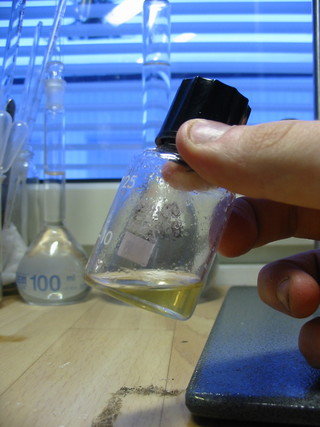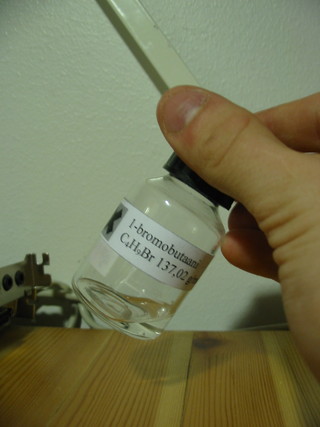kaviaari
Hazard to Self
 
Posts: 80
Registered: 21-12-2005
Location: Finland
Member Is Offline
Mood: Going green
|
|
Purification of 1-bromobutane
I made small amount of 1-bromobutane by refluxing 11,1g of sodium bromide, 10ml of n-butanol and 10ml of sulphuric acid. I have washed the organic
layer with 10ml of water, 2x10ml of NaHCO3(aq), 2x10ml of H2O and 10ml of saturated NaCl solution. The organic layer was dried with a half of a
teaspoon of anhydr. MgSO4. The ammount of product is 3,4ml and it is still quite yellow. How could I get rid of the bromine that is still in the
solution? Because of the small amount of the product I can't really distillate it.

|
|
|
Nicodem
Super Moderator
      
Posts: 4230
Registered: 28-12-2004
Member Is Offline
Mood: No Mood
|
|
The yellow color is not from bromine but from side products. You need to distill it or else you can not be sure of having pure enough n-butyl bromide.
The small amount is not a problem. You can distill it by bulb-to-bulb.
…there is a human touch of the cultist “believer” in every theorist that he must struggle against as being
unworthy of the scientist. Some of the greatest men of science have publicly repudiated a theory which earlier they hotly defended. In this lies their
scientific temper, not in the scientific defense of the theory. - Weston La Barre (Ghost Dance, 1972)
Read the The ScienceMadness Guidelines!
|
|
|
kaviaari
Hazard to Self
 
Posts: 80
Registered: 21-12-2005
Location: Finland
Member Is Offline
Mood: Going green
|
|
I distillated the product in 100ml flask using only NS14-still head and snow-cooled recieving test tube. About 1ml of clear liquid distillated off at
about 100 degrees celsius. It looks very clear and in all ways very neat (picture added). If I give this a second try I scale it up a bit and
distillate it straight from the reaction flask. I am quite happy having this as my first successful organic synthesis. Thanks Nicodem.
EDIT: And those who can read finish and/or like pictures http://koti.mbnet.fi/kaviaari/orgsynt/index.html
[Edited on 27-2-2007 by kaviaari]

|
|
|
garage chemist
chemical wizard
    
Posts: 1803
Registered: 16-8-2004
Location: Germany
Member Is Offline
Mood: No Mood
|
|
What strength was the H2SO4? Not concentrated I hope! If it is too strong, it can oxidise some of the bromide to bromine and this can brominate or
oxidise you alcohol, giving aldehyde and brominated byproducts. Also, too high a concentration of H2SO4 promotes ether formation which is also
unwanted.
|
|
|
kaviaari
Hazard to Self
 
Posts: 80
Registered: 21-12-2005
Location: Finland
Member Is Offline
Mood: Going green
|
|
| Quote: | Originally posted by garage chemist
What strength was the H2SO4? Not concentrated I hope! If it is too strong, it can oxidise some of the bromide to bromine and this can brominate or
oxidise you alcohol, giving aldehyde and brominated byproducts. Also, too high a concentration of H2SO4 promotes ether formation which is also
unwanted. |
According to http://www.orgsyn.org/orgsyn/chemname.asp?nameID=52707 one should be using conc. sulphuric acid. I didn't do the whole synthesis according to
this. I kind of a mixed it with the information on this blackboard http://www.york.cuny.edu/~jilee/lectureboard_sn2.jpg. Adding was done slowly and in an snowbath.
|
|
|
pantone159
National Hazard
   
Posts: 586
Registered: 27-6-2006
Location: Austin, TX, USA
Member Is Offline
Mood: desperate for shade
|
|
I have two organic experiments textbooks that both cover this synthesis, and they both explicitly say that concentrated H2SO4 is what is used.
|
|
|
Magpie
lab constructor
    
Posts: 5939
Registered: 1-11-2003
Location: USA
Member Is Offline
Mood: Chemistry: the subtle science.
|
|
My lab manual (Pavia et al) specifies that con sulfuric be used, but water is also added. Ie, con sulfuric/water volume ratio is 14/17.
Nice going kaviaari, and welcome to the wonderful world of organic synthesis. 
The single most important condition for a successful synthesis is good mixing - Nicodem
|
|
|
Ozone
International Hazard
    
Posts: 1269
Registered: 28-7-2005
Location: Good Olde USA
Member Is Offline
Mood: Integrated
|
|
Obtaining a pure product is the greatest thing ever (particularly after the "Tar" that is ever-present in the development of most synthetic methods).
Concentrated H2SO4 is my experience with this as well.
Now all you need are some qualitative tests...
Congratulations!
O3
-Anyone who never made a mistake never tried anything new.
--Albert Einstein
|
|
|
laoqianxiu
Harmless

Posts: 8
Registered: 1-3-2007
Location: CHN US
Member Is Offline
Mood: crystalline
|
|
it's a good idea
|
|
|
Nicodem
Super Moderator
      
Posts: 4230
Registered: 28-12-2004
Member Is Offline
Mood: No Mood
|
|
Concentrated H2SO4 is just fine for primary alcohols. It will not oxidize the bromide as it gets diluted by the alcohol anyway (actually H2SO4 can be
used even for the preparation of alkyl iodides if the reaction is carefully performed). With the secondary alcohols it is best to use a bit less than
concentrated H2SO4 (let's say 60-85%) since otherwise quite some elimination product forms. With alcohols longer than (iso)propanol an excess of H2SO4
and NaBr must be used or else the yields are terrible. More information can be found in the isopropyl bromide thread.
…there is a human touch of the cultist “believer” in every theorist that he must struggle against as being
unworthy of the scientist. Some of the greatest men of science have publicly repudiated a theory which earlier they hotly defended. In this lies their
scientific temper, not in the scientific defense of the theory. - Weston La Barre (Ghost Dance, 1972)
Read the The ScienceMadness Guidelines!
|
|
|
kaviaari
Hazard to Self
 
Posts: 80
Registered: 21-12-2005
Location: Finland
Member Is Offline
Mood: Going green
|
|
I gave this a second try. After 30min of refluxing mixture was distilled. Fractions weren't very clear so I recieved everything distilling under
100°C to one flask. When the temperature got over 100°C I changed the recieving flask and then something very odd happened. The temperature jumped
to 110°C. A fraction smelling a lot like bromobutane came off, but I am not sure of its purity. I used heating mantel and magnetic stirring. I think
that I should pour all the fractions back to the reaction flask and try again with an oil bath.
|
|
|